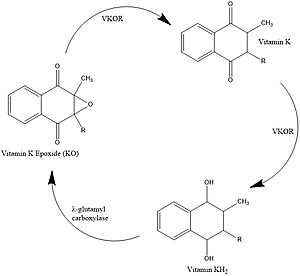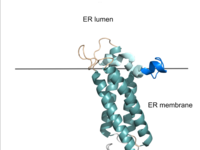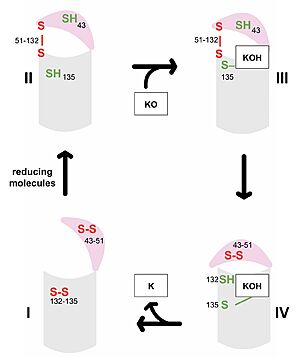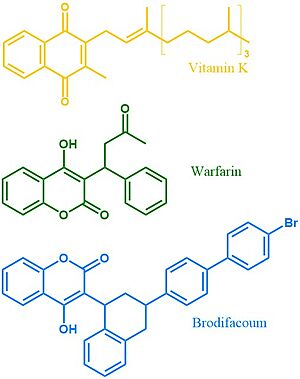Sandbox Reserved 1724
From Proteopedia
(Difference between revisions)
| Line 31: | Line 31: | ||
[https://en.wikipedia.org/wiki/Warfarin Warfarin] is the most widely prescribed oral anticoagulant and targets blood clotting via inhibition of VKOR. The FDA approved uses for cardiac conditions (myocardial infarction, atrial fibrillation) as well as for deep vein thrombosis and pulmonary embolism. Due to the inhibition of the normal blood clotting cycle, patients taking warfarin are at risk for hemorrhage which can occur anywhere in the body. <ref name="Patel">PMID:29261922</ref> | [https://en.wikipedia.org/wiki/Warfarin Warfarin] is the most widely prescribed oral anticoagulant and targets blood clotting via inhibition of VKOR. The FDA approved uses for cardiac conditions (myocardial infarction, atrial fibrillation) as well as for deep vein thrombosis and pulmonary embolism. Due to the inhibition of the normal blood clotting cycle, patients taking warfarin are at risk for hemorrhage which can occur anywhere in the body. <ref name="Patel">PMID:29261922</ref> | ||
| - | Warfarin is a <scene name='90/904330/Bothsubstratevkor/2'>structural mimic</scene> of Vitamin K that occupies the VKOR binding site, acting as a competitive inhibitor. Warfarin mimics vitamin K by binding to the same <scene name='90/904329/Warfarinhbond/ | + | Warfarin is a <scene name='90/904330/Bothsubstratevkor/2'>structural mimic</scene> of Vitamin K that occupies the VKOR binding site, acting as a competitive inhibitor. Warfarin mimics vitamin K by binding to the same <scene name='90/904329/Warfarinhbond/7'>substrate binding residues</scene>(Asn80 and Tyr139) in the active site. Warfarin also shares the same <scene name='90/904329/Warfarinhydroaa/1'>hydrophobic interactions</scene> within the binding site that KOH experiences (Phe83, Phe87, and Tyr88). Warfarin binding also depends on the VKOR catalytic cysteines. Warfarin is able to bind to the fully oxidized open form of VKOR as shown in <scene name='90/904329/Cat_cycle_step1_warf/3'>step I</scene> of the catalytic cycle. Once Warfarin binds, VKOR is considered to be in a closed conformation since the substrate cannot enter, despite the lack of disulfide bridge changes. Warfarin can also bind to the partially oxidized form of VKOR as shown in <scene name='90/904329/Cat_cycle_step2_warf/2'>step II</scene> of the catalytic cycle. |
There are around 30 known missense mutations that lead to warfarin resistance in patients, but these mutations do not affect Vitamin K binding for reasons which are not yet fully understood. Such patients require higher doses of warfarin to reach therapeutic level or require a different anticoagulant drug. <ref name="Wu">PMID:29743176</ref> | There are around 30 known missense mutations that lead to warfarin resistance in patients, but these mutations do not affect Vitamin K binding for reasons which are not yet fully understood. Such patients require higher doses of warfarin to reach therapeutic level or require a different anticoagulant drug. <ref name="Wu">PMID:29743176</ref> | ||
Revision as of 20:06, 18 April 2022
–
| This Sandbox is Reserved from February 28 through September 1, 2022 for use in the course CH462 Biochemistry II taught by R. Jeremy Johnson at the Butler University, Indianapolis, USA. This reservation includes Sandbox Reserved 1700 through Sandbox Reserved 1729. |
To get started:
More help: Help:Editing |
Vitamin K Epoxide Reductase
| |||||||||||
References
- ↑ 1.0 1.1 Stafford DW. The vitamin K cycle. J Thromb Haemost. 2005 Aug;3(8):1873-8. doi: 10.1111/j.1538-7836.2005.01419.x. PMID:16102054 doi:http://dx.doi.org/10.1111/j.1538-7836.2005.01419.x
- ↑ 2.0 2.1 Blanchard RA, Furie BC, Jorgensen M, Kruger SF, Furie B. Acquired vitamin K-dependent carboxylation deficiency in liver disease. N Engl J Med. 1981 Jul 30;305(5):242-8. doi: 10.1056/NEJM198107303050502. PMID:6165889 doi:http://dx.doi.org/10.1056/NEJM198107303050502
- ↑ Swanson JC, Suttie JW. Vitamin K dependent in vitro production of prothrombin. Biochemistry. 1982 Nov 9;21(23):6011-8. doi: 10.1021/bi00266a044. PMID:6758841 doi:http://dx.doi.org/10.1021/bi00266a044
- ↑ 4.00 4.01 4.02 4.03 4.04 4.05 4.06 4.07 4.08 4.09 4.10 4.11 Liu S, Li S, Shen G, Sukumar N, Krezel AM, Li W. Structural basis of antagonizing the vitamin K catalytic cycle for anticoagulation. Science. 2020 Nov 5. pii: science.abc5667. doi: 10.1126/science.abc5667. PMID:33154105 doi:http://dx.doi.org/10.1126/science.abc5667
- ↑ 5.0 5.1 Patel S, Singh R, Preuss CV, Patel N. Warfarin PMID:29261922
- ↑ Wu S, Chen X, Jin DY, Stafford DW, Pedersen LG, Tie JK. Warfarin and vitamin K epoxide reductase: a molecular accounting for observed inhibition. Blood. 2018 Aug 9;132(6):647-657. doi: 10.1182/blood-2018-01-830901. Epub 2018, May 9. PMID:29743176 doi:http://dx.doi.org/10.1182/blood-2018-01-830901
- ↑ 7.0 7.1 Chong YK, Mak TW. Superwarfarin (Long-Acting Anticoagulant Rodenticides) Poisoning: from Pathophysiology to Laboratory-Guided Clinical Management. Clin Biochem Rev. 2019 Nov;40(4):175-185. doi: 10.33176/AACB-19-00029. PMID:31857739 doi:http://dx.doi.org/10.33176/AACB-19-00029
Student Contributors
Izabella Jordan, Emma Varness




